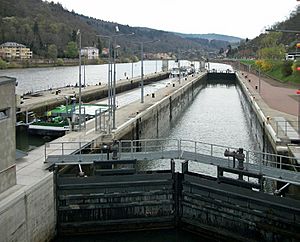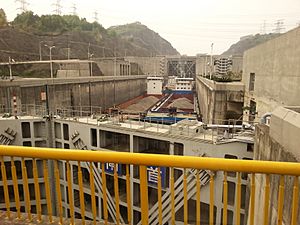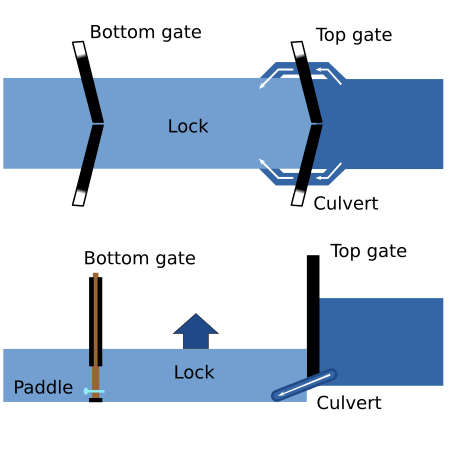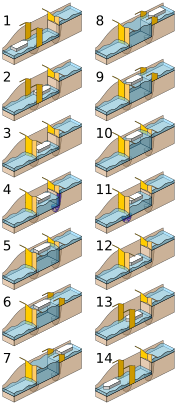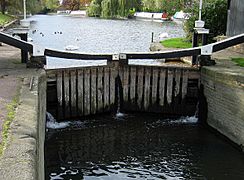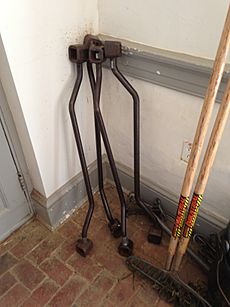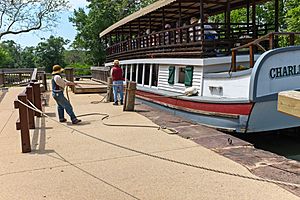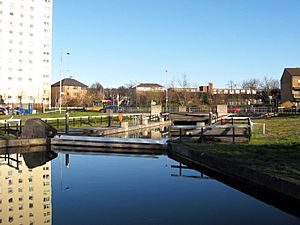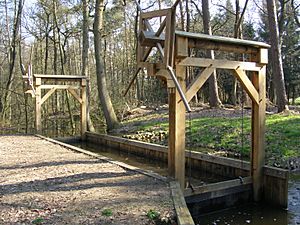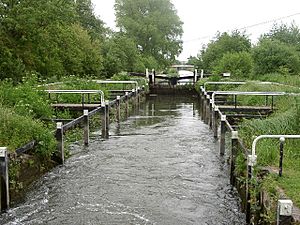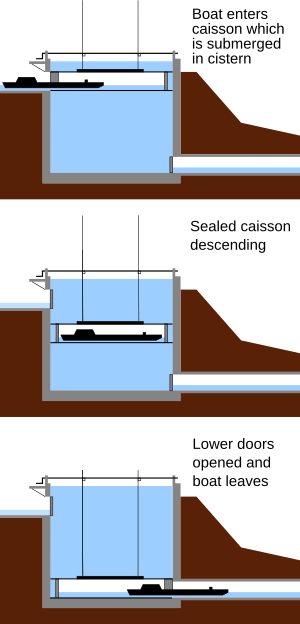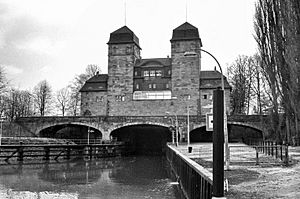Lock (water navigation) facts for kids
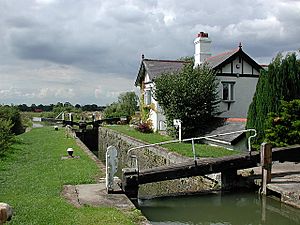
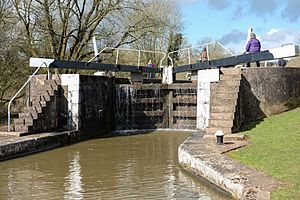
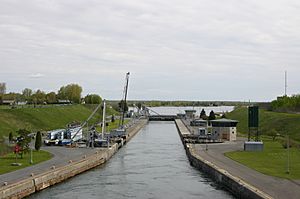
A lock is a special device used on rivers and canals. It helps boats and ships move between parts of the water that are at different levels. Imagine a staircase for boats! The main part of a lock is a closed space where the water level can be changed. This is different from other systems like boat lifts, where the whole chamber moves up or down.
Locks make rivers easier to travel on. They also allow canals to cross land that isn't flat. Newer canals often use more and bigger locks to create a straighter path.
Contents
Pound Locks: How They Work
The most common type of lock today is called a pound lock. It has a chamber with gates at both ends. These gates control the water level inside the lock. An older design, called a flash lock, only had one gate.
Pound locks were first used in China during the Song Dynasty (960–1279 CE). A smart engineer named Qiao Weiyue invented them in 984. Before locks, boats used double slipways, which caused many problems. The Chinese scientist Shen Kuo wrote about these locks in 1088. Later, a history book called Song Shi (written in 1345) fully described them:
The book said the two gates were about 50 paces apart. The whole area was covered like a shed. When the gates closed, water would build up like a tide until it reached the right level. Then, it was allowed to flow out.
In the Grand Canal, the water level could be raised by about 138 feet (42 m) using these locks. In medieval Europe, a type of pound lock was built in 1373 in the Netherlands. The first true pound lock in Europe was built in 1396 in Belgium. Later, an Italian engineer named Bertola da Novate built 18 pound locks in Italy between 1452 and 1458.
How a Lock Operates
Every pound lock has three main parts:
- A waterproof chamber: This is the space that connects the higher and lower parts of the canal. It's big enough for one or more boats. The chamber stays in place, but its water level can change.
- Gates: There's a gate (or a pair of half-gates) at each end of the chamber. A gate opens to let a boat in or out. When closed, it holds the water.
- Lock gear: This is the system that fills or empties the chamber. It's usually a simple valve that lets water flow in or out. Bigger locks might use pumps.
Here's how a lock works if a boat is going downstream and the lock is already full:
- The entrance gates open, and the boat moves inside.
- The entrance gates close behind the boat.
- A valve opens, letting water drain out of the chamber. This lowers the boat.
- The exit gates open, and the boat moves out.
If the lock was empty, the boat would have to wait about 5 to 10 minutes for it to fill. For a boat going upstream, the process is the opposite. The boat enters an empty lock, and then the chamber fills with water from the higher level. The whole process usually takes 10 to 20 minutes. This depends on the lock's size and if the water level was already set for the boat.
Boaters are often happy to see another boat coming towards them. This is because the other boat will have just left the lock at their water level. This means the lock is already set for them, saving about 5 to 10 minutes!
Lock Parts and Terms
Rise: How High the Water Changes
The rise is how much the water level changes in the lock. The two deepest locks in England are Bath Deep Lock and Tuel Lane Lock. Both raise or lower boats by almost 20 feet (6.1 m). These locks were made by combining two smaller locks when the canals were fixed up.
For comparison, the Carrapatelo and Valeira locks in Portugal can lift boats by 115 and 108 feet (35 and 33 m)! The Ardnacrusha locks in Ireland can lift boats by 100 feet (30 m).
Pound: The Water Between Locks
A pound is the flat stretch of water between two locks. It's also called a reach.
Cill: The Underwater Ledge
The cill (or sill) is a narrow ledge that sticks out from under the upper gates into the lock chamber. It's dangerous for a boat to get caught on the cill when going down a lock. The front edge of the cill is usually marked with a white line on the lock side. Some locks have a thick piece of oak to protect the cill.
Photo gallery
-
Water saving gear on the Birmingham Canal Navigations.
-
Controls for a lock gate on a canal.
Gates: The Watertight Doors
Gates are the waterproof doors that seal off the lock chamber. There's a gate (or two half-gates) at each end. They are often made of strong wood like oak or elm, but sometimes steel is used now. The most common type, called miter gates, was invented by Leonardo da Vinci around the late 1400s.
Paddle: Controlling the Water Flow
A paddle is a valve that lets water in or out of the lock. On older canals like the Erie Canal, operating the paddles could be dangerous. Water pressure could make the handle spin violently, possibly injuring someone or knocking them into the canal.
Windlass ("Lock Key"): Opening the Paddles
A windlass is a special crank or "lock key" used to open and close the paddles. On the Chesapeake and Ohio Canal, lockkeepers had to remove the windlasses at night. This was to stop people from using the locks without permission.
Swell: Helping Boats Move
A swell was created by quickly opening the paddle valves in the lock gates. This would cause a rush of water. Sometimes, lock operators would create a swell to help boats traveling downstream exit the lock. If a boat was stuck, the crew might ask for a "back swell" (opening and closing paddles a few times) to create waves and help them move.
On the Erie Canal, some heavy boats needed a swell to get out of the lock. However, the canal managers didn't like swelling. It wasted too much water, which could make the water level too low in the section above the lock. It also raised the water level below the lock, sometimes causing boats to hit bridges or get stuck.
Snubbing Posts: Stopping Boats Safely
On canals where boats were pulled by horses or mules, snubbing posts were used to slow or stop a boat in the lock. A heavy boat moving fast could easily destroy the lock gate. To prevent this, a rope was wrapped around a snubbing post as the boat entered the lock. Pulling on the rope would slow the boat down because of the friction against the post.
In 1873, a boat called the Henry C. Flagg crashed into and broke the downstream gates of Lock 74 because the crew didn't snub it. The rush of water broke the upstream gates too, sinking the boat. This stopped all canal traffic for 48 hours!
Different Types of Locks
Composite Locks: Saving Materials
To save money, especially where good stone was hard to find, composite locks were built. These locks used cheaper stone or rubble for the main structure. The inside walls were then lined with wood to protect the boats. This was done on canals like the Chesapeake and Ohio Canal.
Powered Locks: Bigger and Stronger
On large, modern canals, the gates and paddles are too big to be moved by hand. They are operated by powerful hydraulic or electric machines. On the Caledonian Canal, the lock gates were once moved by people using capstans (large turning posts). By 1968, these were replaced with hydraulic power.
Fish Ladders: Helping Fish Travel
Locks (and dams) can block fish from moving up rivers. Some fish, like salmon, need to swim upstream to lay their eggs. To help them, special structures called fish ladders are often built. These allow fish to bypass the locks and continue their journey.
Special Lock Designs
Doubled or Paired Locks: Faster Travel
Sometimes, locks are built side-by-side on the same waterway. This is called doubling or pairing. It helps speed things up, especially when the canal is busy. It also means a boat might find a lock already set for them, saving time.
The Panama Canal has three sets of doubled locks. Another famous example was the staircase of five doubled locks at Lockport, New York. These locks helped boats climb or descend a 60 feet (18 m) hill, which was a huge engineering achievement in the 1800s.
Stop Locks: Controlling Water Levels
A stop lock was built when a new canal joined an older one. If the water level in the new canal couldn't always be guaranteed to be high, the older canal company would build a stop lock. This lock had gates pointing towards its own canal. It could be closed if the new canal's water level was low. This created two locks right next to each other, with gates facing opposite ways.
Round Locks: Unique Design
The most famous example of a round lock is the Agde Round Lock on the Canal du Midi in France. This lock is part of the main canal line and also allows boats to enter the Hérault River.
Drop Locks: For Same-Level Waterways
A drop lock is used when the water levels at both ends of the lock are the same height. This type of lock can only be emptied by letting water flow away to a lower stream or by pumping water back up to the canal. The only drop lock ever built is at Dalmuir on the Forth and Clyde Canal in Scotland. It was built to replace a swing bridge with a fixed bridge, to avoid stopping busy road traffic.
Very Large Locks: Giants of the Waterways
In 2016, the Kieldrecht Lock in Belgium became the world's largest lock by volume. In 2022, the IJmuiden sea lock in the Netherlands became the world's largest by size. It is 500 m (1,600 ft) long, 70 m (230 ft) wide, and has a usable depth of 18 m (59 ft).
The size of locks can also be measured by how much they lift or lower boats. For example, the Bollène lock in France has a fall of at least 23 m (75 ft). The Oskemen Lock in Kazakhstan has a huge drop of 42 m (138 ft)!
History of Locks
Early Pound Locks
The idea of a pound lock came from an earlier design called a "staunch," which was just a single gate. By adding an upper gate, engineers created a chamber that could be filled and emptied. This type of lock was known in ancient China and Europe. Greek engineers used them in the Canal of the Pharaohs around 284 to 246 BC.
Pound locks were first widely used in medieval China during the Song Dynasty (960–1279 CE). A tax administrator named Qiao Weiyue was tired of grain barges crashing on the West River. In 984, he built two gates about 250 feet apart, covered by a roof. This created a short canal section, which was effectively a pound lock. Water could be let in from the canal above and emptied into the canal below.
Turf-Sided Locks: Earthy Beginnings
A turf-sided lock is an old type of canal lock. Instead of brick or stone walls, it uses earth banks to form the lock chamber. These banks would grow grass and other plants. This design was common on river navigations in the early 1700s in Britain. Because the sides were sloped, these locks were wide when full and needed more water to operate than modern locks. Most turf-sided locks in Britain have been rebuilt with brick or stone. Only a few good examples remain, like Monkey Marsh Lock.
Water Saving Techniques
Water Saving Basins (Side Ponds)
Some locks have special reservoirs called "side ponds" (or "water saving basins"). These help save water when the lock is operated. The Droitwich Canal in England has a set of three locks that all use side ponds to save water.
Other Ways to Move Boats
Inclined Plane: A Boat Roller Coaster
An inclined plane is a system where boats are moved up or down a slope on a cradle or carriage, often on rails. There are no working inclined planes for boats in the UK right now. But you can see the remains of a famous one at Foxton in England. It allowed wide boats to bypass ten narrow locks.
Caisson Lock: An Underwater Lift
Around 1800, Robert Weldon suggested using caisson locks in England. In this system, the lock chamber was 60 ft (18.3 m) deep and held a completely closed wooden box big enough for a barge. This box moved up and down in the deep pool of water. The water never left the chamber, so using the lock didn't waste any water. The boat entered the box, the door sealed, and the box itself moved up or down. One of these was built, but it had problems and wasn't used much.
Hydro-Pneumatic Canal Lift: Air Power
Inspired by the caisson lock, William Congreve patented a "hydro-pneumatic double balance lock" in 1813. This design used two locks with air-filled caissons that could be raised and lowered by moving compressed air between them. One was built in London around 1817, but it didn't work well and was soon replaced by regular locks.
Shaft Lock: A Deep Hole
A shaft lock looks a bit like a caisson lock. It has a deep shaft with normal gates at the top. The lower gates are reached through a short tunnel. These gates only close off the tunnel, so they don't need to be as tall as the shaft. Famous examples are in France, the Czech Republic, and Germany. The shaft lock at Minden, Germany, has a fall of 12.7 metres (42 ft). It has tanks that save water when the lock is emptied or filled.
Diagonal Lock: Slanted Movement
A diagonal lock is like a shaft lock, but the shaft is built on a slope. Boats are tied to floating posts that guide them along the slanted shaft as it fills or empties. This new design is being considered for new or restored canals in Britain.

See also
 In Spanish: Esclusa para niños
In Spanish: Esclusa para niños
- Canal Safety Gates
- Water slope
- Control lock


